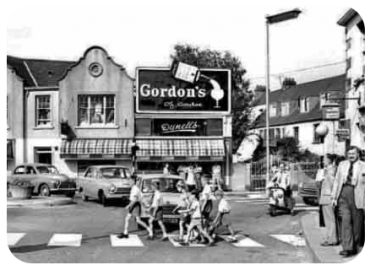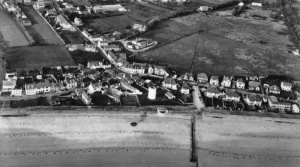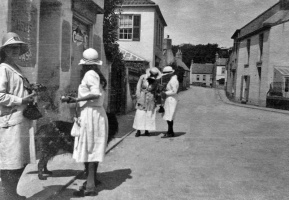Beaumont is a village on Jersey's south coast between St Helier and St Aubin. Until roads began to be built in the early 19th century, Beaumont was more or less isolated, but now it has been swept up in the ribbon development which stretches virtually the full length of St Aubin's Bay.
There are a few small shops, two public houses, but otherwise the area is largely given over to housing.
History
Beaumont is thought of today mainly as a busy intersection for traffic going east, west and north, but this is far removed from an area described in early census records as a village. This image remained well into the 20th century, changing only as traffic increased, with the junction altering to accommodate more vehicles.
Sandybrook
Modern life has also changed the face of Sandybrook. A small rural community at the base of St Peter’s Valley, it has been partly developed for housing and is now often used as a cut-through by vehicles travelling to and from the valley.
With its varied topography including a valley, a stream, marshland and a coastline, the history of this combined area is an interesting mix which led to the growth of a diverse community during the 19th and 20th centuries.
The 1795 Richmond Map shows mainly dunes, rough land and orchards, with just a few houses dotted about. With no coast road at that time, the main route across was inland via St Peter’s Valley Road and along roads such as Old Beaumont Hill, Sandybrook Lane and Rue du Craslin.
By the time of the Godfray Map of 1849, Route de la Haule had been built, and although little development had taken place in Sandybrook and the coastal areas, there was now a small gathering of houses at Beaumont and the area is labelled Beaumont Village.
Beaumont Hill
Route de Beaumont, the busy road we know more commonly as Beaumont Hill, is not on this map, and the route to St Peter’s Village would still have been along the steep and winding Old Beaumont Hill. A plan of a proposed new road through the valley dated 1874 shows that the current, more popular route, was under consideration by then.
An iconic feature on the hill is the cannon. It was cast in 1551 by John Owen, a well-respected foundry master who made artillery for King Henry VIII. A small number of these were cast to defend the island following an abortive French invasion in 1549, and this one may be the last of its kind.
At some point the cannon was removed to England. It was later discovered by Sir John Le Couteur while he was working in London in 1839. Recognising its significance, he returned it to Jersey and it was placed on Beaumont Hill.
Sandybrook includes part of both the Vingtaine de la Vallée in St Lawrence and the Vingtaine de St Nicolas in St Peter, with the boundary between the parishes running along the perquage through Goose Green Marsh and on to where the stream, Douet du Canard, meets the coast.
Perquages became subject to the ‘’visite des chemins’’ in the 16th century and the section from Tesson Mill to Goose Green Marsh is described by the 1645 visite as passing near a mill named Moulin de la Cave. No longer in existence, this old malt mill was in the vicinity of Man’s Garden and references to La Cave are still evident today in Sandybrook Lane, with the flats named Maison La Cave and La Cave Cottage next door.
Sandybrook Hospital
Property contracts reveal that the Sandybrook Hospital site was once occupied by a house called Sandybrooke, and that this, along with adjacent land, was sold by George Francis Moignard and Monica Clara Moignard to the public of Jersey on 27 September 1947.
It opened two months later as an annexe to the General Hospital to care for old and infirm ladies, including those who were inmates of the Poor Law Department of the General Hospital, with the intention that the stigma attached to a Poor Law institution be eliminated.
As the 19th century progressed, Beaumont Village continued to expand and the population increased. Methodism in Jersey was becoming established, with one of the early groups, the Primitive Methodists, setting up their first chapel in Aquila Road in 1839. Looking to take their work outside St Helier, they built a chapel at Beaumont which was opened in 1868.
It stood towards the bottom of Beaumont Hill, in the area of Brisbane Cottage, and operated for many decades. With support dwindling, it closed its doors in 1938 and the building was demolished soon after the Occupation.
As in most villages, drinking establishments have existed in Beaumont for centuiries, with the Forester’s Arms purporting to be the oldest pub in Jersey, dating back to 1717. Others are recorded in census records, with the British Hotel listed as a hotel and inn from 1861. At that time it did not extend from the corner of Beaumont Hill.
When it was run by Arthur Gueno between 1955 and 1985 he and his family lived in the adjacent house to the east. It was an old-fashioned workers’ pub and popular hotel, and it took guests through the summer, some of whom returned year after year.
Village school
On 8 December 1899, with the population of the village expanding, the Committee of Elementary Education decided that a school should be built at Beaumont. The site, which is now the home of Besco Laundry, was chosen and the land was purchased from A B Voisin at a cost of £150 per vergée.
Listed as the Parochial School, Beaumont, it first appears in the Education Department’s annual returns in 1902. By 1905 50 pupils attended the school. The head teacher was Alice Nicolle, on an annual salary of £70.
The school was to have a short life and in October 1932 the Public Instruction Committee proposed its closure on the grounds that it was proving very costly to run, the numbers having diminshed to 22 pupils.
This was not the only school to operate at Beaumont. There was a boarding school recorded as Beaumont House, or Beaumont Academy, in census returns from 1871 to 1891. It was run by George Boyer, who lived there with his family. A notable pupil was Henry Thomas Bosdet, the artist responsible for creating some of the stained-glass windows in some of the parish churches.
The school ran until 1899, when the property, called l’Hermitage, was sold, later to become the site of the l’Hermitage Hotel.
By the end of the 19th century Beaumont Village also had a post office, a dairy and livery stables, together with a number of shops, including Dunell’s, which is still operating today.
Beaumont cottage formerly owned by Lillie Langtry





















































